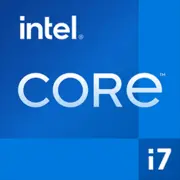Intel Core i7-11800H

Intel Core i7-11800H: Tiger Lake Power for Hybrid Tasks
Relevant as of April 2025
Architecture and Process Technology: 10 nm SuperFin and 8 cores for Multitasking
The Intel Core i7-11800H processor, released in 2021, remains relevant in 2025 due to its balanced architecture. It is built on a 10 nm SuperFin technology, offering high transistor density and energy efficiency. Key features include:
- 8 cores and 16 threads (Hyper-Threading) with a base frequency of 2.3 GHz and a turbo boost of up to 4.6 GHz;
- 24 MB of L3 cache — double that of the previous generation Comet Lake (i7-10875H);
- Integrated Intel UHD graphics for the 11th generation with 32 EU (Execution Units) and support for 4K@60 Hz.
The Willow Cove architecture (part of the Tiger Lake-H platform) is optimized for gaming and professional tasks. For instance, support for PCIe 4.0 allows connecting SSDs with throughput up to 7 GB/s, which is critical for video editing. The built-in GPU handles lightweight games like CS:GO (60-80 FPS at medium settings), but a discrete graphics card is necessary for AAA titles.
Power Consumption and TDP: A Balance Between Power and Portability
The nominal TDP of the processor is 35 W, but in turbo mode, consumption can reach 65–70 W. This requires a well-thought-out cooling system. For example, the ASUS ZenBook Pro 15 (2025) utilizes hybrid cooling with two fans, keeping temperatures under load within 85–90°C.
Tip: When choosing a laptop with the i7-11800H, pay attention to the thickness of the chassis. In compact devices (like the Dell XPS 15), the processor may throttle due to overheating, lowering frequencies to 3.8 GHz. This issue does not occur in gaming models (like the MSI GP66).
Performance: From Office Work to 4K Rendering
Geekbench 6 highlights the strengths of the chip:
- 1894 points in single-threaded tests — comparable to the Apple M1 Pro (1850 points);
- 7864 points in multi-threaded — slightly below the AMD Ryzen 7 5800H (8100 points).
Real-world tasks:
- Office Work: Running 50+ tabs in Chrome, concurrently working with Excel and Photoshop — the processor remains responsive.
- Multimedia: Rendering a 10-minute 4K video in Premiere Pro takes about 12 minutes compared to around 15 minutes with the i7-10750H.
- Gaming: Paired with an RTX 3060 in Cyberpunk 2077 (Ultra, DLSS) — stable 60 FPS.
Turbo mode activates during short-term loads (e.g., launching a game), but in prolonged scenarios (like rendering), frequencies drop by 10–15%.
Usage Scenarios: Who is the i7-11800H Suitable For?
1. Gamers: When paired with a GPU like the RTX 3060 or better, the processor reveals its potential in games with complex AI populations (e.g., Horizon Forbidden West).
2. Creative Professionals: Editors and 3D designers will appreciate the rendering speed and Thunderbolt 4 support for external storage.
3. Students and Hybrid Users: Multitasking + battery life of up to 8 hours in web browsing mode.
Example: The Acer Predator Helios 300 (i7-11800H + RTX 3070) in 2025 is priced at $1200–$1400 and is suitable for streaming and editing.
Battery Life: How Long Will the Battery Last?
With a TDP of 35 W, battery life greatly depends on the tasks:
- YouTube viewing (1080p): 6–7 hours (80 Wh battery);
- AutoCAD work: 2.5–3 hours;
- Sleep mode with active Wi-Fi: Up to 10 days.
Power-saving technologies include:
- Intel Speed Shift — dynamic frequency adjustment to reduce power consumption;
- Dynamic Tuning 2.0 — adaptation to thermal conditions.
Important: In ultrabooks (like the HP Spectre x360), battery life is higher (up to 9 hours) due to optimized BIOS and low-power screens.
Comparison with Competitors: AMD, Apple, and Previous Generations
- AMD Ryzen 7 5800H: Better in multi-threaded tasks (+7%), but weaker in single-threaded (-10%). Price is similar.
- Apple M1 Pro: More energy-efficient (18 hours of battery life), but limited compatibility with Windows software.
- Intel Core i7-12800H (Alder Lake): 20% faster in multi-threading but costs $200–$300 more.
Conclusion for 2025: The i7-11800H is a solid choice for those seeking a balance of price and performance. Laptops based on it currently cost $900–$1300, while equivalents with Alder Lake start at $1400.
Pros and Cons: Is It Worth Buying in 2025?
Strengths:
- High single-threaded performance for games and applications;
- Support for PCIe 4.0 and Thunderbolt 4;
- Affordable price in the new and used device segment.
Weaknesses:
- Heating under prolonged loads;
- Integrated graphics are weaker compared to AMD Radeon RX Vega 7;
- Lags behind the new Ryzen 7000 in multi-threading.
Laptop Selection Recommendations
1. Gaming Laptop: Look for models with effective cooling (at least 4 heat pipes) and a GPU no lower than the RTX 3060. Example: Lenovo Legion 5 Pro ($1100–$1300).
2. Workstation: Requires 32 GB of RAM and a 1 TB SSD (PCIe 4.0). Recommended: MSI Creator Z16 ($1500).
3. Ultrabook: Focus on weight (up to 1.8 kg) and a screen with high PPI. The Huawei MateBook X Pro (2025) is a good option at $1300.
Tip: Ensure your laptop supports DDR4-3200 MHz to unlock the processor's potential.
Final Conclusion: Who Is the i7-11800H For?
The processor is ideal for those needing versatility:
- Gamers on a budget;
- Freelancers working with graphics and code;
- Users valuing system responsiveness.
Key Benefits: Power for most tasks in 2025, compatibility with modern standards, and optimal price-to-performance ratio. If you are not willing to pay extra for Alder Lake or Ryzen 7000, the i7-11800H is a reasonable choice.
Basic
CPU Specifications
Memory Specifications
GPU Specifications
Miscellaneous
Benchmarks
Compared to Other CPU
Share in social media
Or Link To Us
<a href="https://cputronic.com/en/cpu/intel-core-i7-11800h" target="_blank">Intel Core i7-11800H</a>